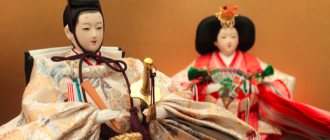Shogi
Shogi
is one of the oldest Japanese mind games.
It was introduced in the 8th century from China and comes from the ancient Indian game chaturanga
. Chaturanga is the common ancestor of chess and shogi. Therefore, shogi is similar to chess in many ways. Shogi acquired its modern form in the 16th century; its final reform was carried out by Emperor Gonara.
During the reign of the Tokugawa shoguns, shogi and go were recognized as games that developed strategic and tactical military thinking. All other board games were prohibited to samurai, but these two, on the contrary, received government support. Tokugawa Ieyasu established the position of shogi-dokoro
- the main court teacher of shogi, who was identified during the constantly held championships. Only shogi-dokoro had the right to confer master titles. After the Meiji Restoration, government support for shogi was withdrawn and the position of shogi-dokoro was abolished.
A shogi board is a square of 9x9 cells, numbered from top to bottom and from right to left. On top are placed in three rows white “figures” - pentagonal tablets with hieroglyphic inscriptions, below - “figures” of blacks in a mirror image of the order of whites. “White” and “black” are the colors of the players, not the figures; the identity of the latter is determined by the direction of the acute corner of the board. Pointing down is white, pointing up is black.
The figures include: king ( Gyoku
), rook (
Hisha
), bishop (
Kaku
), 2 gold generals (
Kin
), 2 silver generals (
Gin
), 2 knights (
Kei
), 2 spearmen (
Kyo
) and 9 pawns (
Fu
). They move about the same way as chess pieces. Having reached the enemy’s initial location area, all pieces, except for the golden generals and the king, can, at the player’s request, acquire additional movement capabilities - then they are turned over to their reverse side, on which hieroglyphs are written indicating a “strengthened” piece.
Capturing pieces occurs according to chess rules. Captured enemy pieces can be returned to the board at any time (though not to any place) as your own.
Black people start out in shogi (as in all Japanese games). The goal of the game is to checkmate the king. Draws in shogi are very rare.
Shogi players are classified according to the traditional kyu-dan
. The lowest rank is considered to be the 15th kyu, the highest is the 1st. Next, master ranks are assigned: from 1st dan to 9th. Amateur 5th dan is equivalent to professional 5th kyu.
For victories in tournaments you can receive a rank no higher than the 7th professional dan, 8th and 9th are given for contribution to the development of the game and for receiving the title “meijin”
(“master”) - “absolute champion”. Since 1962, the title of meijin corresponds to the title of “world champion” and is awarded based on the results of the annual championship. Previously, this title was for life.
About 20 million people currently play shogi in Japan.
Lesson summary “Travel to Japan. Outdoor games" in the preparatory group
Publications on the topic:
Lesson summary for children with disabilities “Outdoor games” State government social service institution of the Krasnodar Territory “Temryuk Rehabilitation Center for Children and Adolescents.
Synopsis of physical education leisure in the preparatory group “Active games of our parents” Synopsis of physical education leisure Purpose: Formation of positive emotional relationships between adults (parents, teachers) and.
Summary of the entertainment “Travel to Japan for the Flower Festival” with children of the older group (5–6 years old) Purpose: to introduce children to Japan, to introduce children to the Japanese art of origami; the art of ikebana arrangement. Learning Objectives: Initiate.
Summary of the parent meeting in the preparatory group “Active Games of the Russian People” Venue: music (sports) hall. Equipment: long rope, rope. During collection, adults are asked to respond to.
Leisure scenario “Travel to Japan” for children of older and preparatory age Week of games and toys “Travel to Japan” Scenario for children of older and preparatory age Prepared by Yu. A. Parfenova.
Summary of the open lesson “Educational outdoor games for young children on a walk with their parents” Game “Funny Train”. Target. Show the correct selection of outdoor games with simple actions. Specific motor.
Preparatory group. Abstract of the educational activity "Travel to Japan" Type of direct educational activity: educational - educational. Topic: “Travel to Japan.” Objectives: educational:.
Summary of NOD in the senior group “Travel to New Year’s Japan” within the framework of the project “New Year’s traditions from around the world” Goal: to introduce children to the traditions of celebrating the New Year in Japan. Objectives: 1. Educational: to form basic ideas about Japan;
Project in the preparatory group with a compensatory focus “Active games of the peoples of the Volga region” PROJECT CONTENTS 1. Information card of the project. 2. Relevance. 3. Project problem. 4. Goals and objectives of the project. 5. Expected result.
Leisure scenario “Travel to Japan” for children of primary and secondary preschool age for the Week of Games and Toys Leisure scenario “Travel to Japan” (younger and middle age) Developed by Yu. A. Parfenova Conducted by: E. A. Makarova, Yu. A. Parfenova .Children.
Let's play sumo
The transforming robot, although created for JR advertising, is still in an exhibition format. But what I didn’t expect to see among the toys were real sumo wrestlers. Everyone could compete with the heavyweights.
These were long and very fun fights. Preschool children squealed and screamed and rushed around the ring behind the sumo wrestlers. Having caught up, they tried their best to push the 150-kilogram bodies out of the circle. To the delight of those around them, some kids even managed to knock over the wrestlers.
| Kid vs sumo wrestler | photo: Roman Afanasiev |
I really liked the children's world of a Japanese child. There are many games in it that I myself would enjoy playing. After wandering around the exhibition for two hours, I realized that I would definitely return here in a year. I’ll come back to get back to those carefree times of childhood, at least for a moment, when I could play with cars for hours on end.
World Games
- home
- World Games
The games section of the world's peoples contains the most famous and time-tested games. The games presented have a wide geography and an interesting history of origin. Games of the peoples of the world help us better understand, and perhaps take a different look at, other nations. Games of the peoples of the world reflect the culture and identity of the people. It can be noted that among one people, active, team games predominate, while among another, board, logical games predominate. You can also find very similar games among different nations, but with different names.
Auto racing is a German game for two or more people. To play, you need to take two toy cars, two wooden sticks and two long cords (about 6-9 m). Toy cars should be tied to cords. which, in turn, are tied to sticks. Wooden sticks should be held in the hands of two children. The essence of the game is to, on command, wind the cord around a stick as quickly as possible, thus pulling the car towards you.
Kagome
- This is a Japanese children's game. One of the children is chosen as a “demon”, he closes his eyes and sits down.
The rest of the children dance around him and sing a play song. When the song ends, the “demon” calls the name of the one who is standing behind him and, if the “demon” turned out to be right, this person replaces the “demon”.
This Japanese game can be played by 4 people or more. To do this, you need to draw a large lake with bays, islands and capes on the asphalt. Players choose one “stork” leader, and all other players become “storks”.
The “frogs” sit in the “water”, not having the right to get out to the “land”.
The “stork” must walk along the shore and try to catch the “frog”. The “stork” has the right to jump from “island” to “island”, but cannot enter the “water”. The last “frog” caught becomes a “stork”.
White Stick (Takzhikistan) can be played by more than 10 people. Participants must choose a leader according to the counting count, divide into 2 equal teams and choose a place for the white stick. Then the leader must quietly hide the wand, and the players must look for it. The one who finds the stick carries it to the chosen place, and at this time the players of the other team try to stop him. The wand can be given to your team members.
Argentine game for seven or more people. Before the game, the participants are divided into the driver “locomotive” and the rest of the players “cars”. On a large platform, players each “build a depot” for themselves, outlining a small circle.
In the middle of the platform there is a driver - a steam locomotive. He doesn't have his own depot. The driver goes from one player to another. Whoever he approaches follows him. This is how all the cars are assembled. The locomotive suddenly whistles, and everyone runs to the depot, including the locomotive. The player left without a seat becomes the driver of the locomotive.
A game from Burma played by at least six players with one ball or stone. Players line up at a distance of 30 - 40 cm from each other. Outstretched arms with open palms are held behind the back. One of the players stands behind them. He has a ball or pebble in his hand. Walking along the line, he pretends as if he wants to drop the ball into someone's palm. Players shouldn't look back. Finally he drops the ball into someone's hand. The player who received the ball suddenly breaks out of the line.
Neighbors to the right and left must catch him before he moves. But at the same time they do not have the right to leave the line. If they fail to capture him, he can return to his place and then the game continues. If he is caught, he changes places with the leader.
Statue
- Armenian game for 5 - 20 people.
Players are divided into catchers and runners. One catcher is assigned for every 5 people, and four catchers for every 20 people. As designated by the leader, the catchers go outside the field, and the runners freely position themselves on the site. At the signal, the catchers chase the other players, trying to catch one of them.
The caught person must immediately stop and freeze in place in the position in which he was caught. Anyone who is frozen can be “released” by any player by touching him. The game ends when all players are caught. After this, new catchers are chosen and the game continues.
A runner who, by inertia, runs out of bounds is considered out of the game.
Pull out your handkerchief
is an Azerbaijani game played by 10 or more people.
Scarves are used as equipment. Two teams line up opposite each other at some distance. A line is drawn between them. Each person has a handkerchief or scarf tucked into the back of their belt. By lot, one of the teams becomes the driver. At the judge’s command, the children move forward (the drivers stand still), cross the line, and then the judge shouts: “Fire!” The players run back, and the opponents (drivers) try to catch up with them in order to pull the scarf from their belts. Then the teams change roles.
Shpen is a Belarusian game where a wooden pin is placed in the center of the field, the driver stands next to it, and around the rest of the players with bats in their hands.
Their task is to throw the bat and hit the peg so that it rolls as far from the center as possible. If one of the players succeeds and the peg rolls away, the driver must run up, take it and place it again in the center of the field. At this time, the players run for their bats and pick them up.
The driver, having installed the peg, must try to grab any of the bits, ahead of its owner. If he succeeds, he becomes a player, and the player who did not have time to return his bat becomes a driver. (Sticks flying into the peg can hit the driver, so he needs to be careful not to get hit by the bat).
An Italian game in which two teams are each placed at their own line at some distance from each other, with the leader standing in the middle. He holds a scarf and shouts out numbers. The players whose numbers he called run to him. The one who snatches the scarf from the leader and returns to his place first earns a point.
Peru
A Peruvian game in which players draw circle houses for themselves, and the driver remains “homeless.” Everyone shouts in unison “Kalabasa!” (Go home!) and scatter in their own circles. The “homeless man” turns to one of the players: “Are you selling eggs?” He replies: “I don’t, but maybe he’s selling,” and points to a friend, to whom the “homeless man” goes. In the meantime, the players must change places. If the driver manages to occupy someone else’s house, then he becomes its owner, and the one who remains outside the circle leads.
This is a Hungarian game in which players form a circle with a diameter not exceeding 10 m. The driver becomes the center of the circle. Players throw a small ball to each other. The driver tries to intercept him. At a convenient moment, any of the players can throw the ball at the driver.
If the driver fails to dodge the ball, he remains in the center of the circle.
If successful, he leaves the circle and the player who threw the ball takes his place.
If the driver manages to intercept the ball thrown at him, or during a pass from player to player, he can throw the ball at any player.
If it hits, the player will take his place; if not, he can continue to drive.
“Hag” translated from Uzbek means “crow”, “oksak” means “lame”. Why is the crow lame? Because the one who portrays this crow is jumping on one leg. And the second leg is bent and tied, say, with a belt or scarf. (It doesn’t matter which leg the crow is limping on). Start the game the way you want. If there are only two of you, just race and jump. If there are at least three (dad, mom and me), you may end up with crow's spots. A lot of people have gathered - organize a jumping relay race, splitting into two teams. In this case, the belt or scarf with which the leg is tied passes from one “crow” to another.
This is a Georgian jumping game, which requires several sticks like gorodosh bats (no more than 5 cm thick). The sticks are placed on the ground parallel to one another at a distance of half a meter. The more sticks, the more difficult the game will be. Next to the first stick and the last there is a flat stone: here the jumpers can rest (not for long!). The player who begins the game must, jumping on one leg, go around all the sticks with a snake. On the way back, you need to jump over the sticks, placing your feet perpendicular to them. And again to the stone - but now the feet are placed parallel to the sticks. You finish the game by jumping from stick to stick.
If you get lost or make a mistake, you immediately give way to the next jumper, and after waiting for your turn again, you start all over again. We talked about four ways of jumping, but you can come up with new ones yourself; you can place the sticks in a different way... In general, the competition program will largely depend on your desire and on your ingenuity. In any case, the winner will be the one who completes all the discussed tasks without errors in the least number of attempts.
This is a Lithuanian game played by five people. A rectangular square with a side of 10 m is drawn on the ground or asphalt. Four participants stand in the corners of the square. A circle with a diameter of 1.5 m is drawn in the center of the square, and the fifth player, the fifth, stands in it. The corner players throw the ball at him, and the fifth tries to dodge the ball without going beyond the circle. The player who ends up in the fifth takes his place.
This is a German game for 10 or more people. Chairs according to the number of players are placed in a circle, with their backs facing inward. The players (firefighters) walk around these chairs to the sound of music (tambourine, drum). As soon as the music stops, players must place an item of clothing on the chair they are standing near. Game continues. When each participant removes 3 objects (they end up on different chairs), the alarm sounds: “Fire!” Players must quickly find their items and put them on. Whoever gets dressed the fastest is the winner.
This game is played in Tanzania by 10 or more people. Need a leaf from a tree. Players stand in a circle facing the center. The driver walks behind them and touches the players’ palms with a sheet. Then he places the paper in someone's hand and runs. The player with the sheet is behind him. If the driver runs a circle and is not caught up, he will stand in an empty place, and the player who was chasing him becomes the new driver.
This is a Swiss game for 10-15 people, in which players stand in a circle and choose a hunter who walks behind the players. Suddenly he touches the player's shoulder. The one touched turns and says: “Good morning, hunter!”, and immediately walks in a circle, but in the direction opposite to where the hunter is going. Having walked half a circle, they meet, the player again says: “Good morning, hunter!” And both run to take an empty place in the circle. The one who did not manage to do this becomes a hunter.
This is a Brazilian game for five or more people, where one player is a healthy cat who tries to catch everyone else. Each player who is tainted must place their hand on the exact spot where they were tainted. He also becomes a cat, but a sick one, and helps the healthy cat when catching. A sick cat can only stain with its healthy hand. The player who is not stained wins. He becomes a healthy cat for the next round.
This Uzbek game is played by 5 or more people. On the site, the guys draw a straight line 6 - 10 m long. You have to move along it like on a tightrope. It is allowed to keep your arms at your sides. The losers are those guys who go off the line - “fly off the rope.” According to the rules, one of the players watches the “rope walkers” and the one who comes off the “rope” becomes an observer.
This Belarusian game is played by 10 or more people. The game participants are divided into two equal groups. The players of each group hold on to each other and form one chain with their arms bent at the elbows. At the front of the chain are stronger and more dexterous participants - “groovy”. Standing opposite each other, the “clockwork” also takes each other by the arms bent at the elbows and each pulls them in their own direction, trying to break the enemy’s chain with them, or pull it over the intended line. According to the rules, they start pulling exactly at the signal.
Belarusian folk game. The presenter and the driver hide toys in different places, accompanying the actions with the words: Prela-burning flew overseas, And when she arrived, she sat down somewhere, Whoever finds it first will take it for himself! After these words, everyone scatters around the site, looking for hidden objects. Whoever finds the most wins. Rules of the game. You can start looking for objects only after the spoken words. While laying out toys, everyone should stand with their eyes closed and not peep. You need to hide toys quickly.
Let's play doctor
Japan has earned a reputation for producing the craziest toys. Suffice it to recall Tamagotchi. In the late 90s, virtual pets were raised all over the world. It didn’t take long to look for confirmation that people in the East can still surprise. At the first stand, children “implanted” a heart and lungs into a plastic human skeleton with tweezers.
| A puzzle that received an award from the exhibition jury | photo: Roman Afanasiev |
Children play, parents watch with interest. Surely, after purchasing a surgical kit, the first time at home everything will be the other way around. The principle of the game is simple: take a “spare part”, for example, a liver, and carefully place it inside. Your hand trembled, you made a mistake, you lost. When putting together a “human puzzle,” the child remembers the names of the insides and their place in the body. By the way, the creators of the game won a prize at the Tokyo exhibition in the “Communication” category.
LiveInternetLiveInternet
Quote from SneznyBars message
Read in full In your quotation book or community!
Traditional games of Japan
Japan is an ancient country and over its centuries-old history it has known many games, which, undoubtedly, were played by both children and adults. Some of them have disappeared over the past centuries, some are still alive today. However, the development of the latest computer technologies has had a revolutionary impact on the modern culture of the country, on the pastime and entertainment of its inhabitants. This, in turn, has affected what modern Japanese play today.
Karuta (and its variant "Uta-garuta")
Analogue of European lotto. Originated in the Heian Era. They are still used in Japanese families to teach poetry and hieroglyphs - poems or hieroglyphs with translation are written on cards (often a ready-made poetry collection “Hyakunin isshu” - “100 poets of ancient times” is used for this purpose), then the cards are cut in half and are mixed. The winner is the one who quickly selects the required number of correct pairs. In this way, games contribute to the study of literature and writing. The common name for these card games is karuta.
Traditional children's games
Jianken
Finger throwing game. There are several modifications. The most common one is known in our country as “Rock-paper-scissors”. The "stone" figure - a clenched fist is thrown out, the "scissors" figure - two fingers are spread out - the index and ring fingers in the form of a Latin V, the rest are tucked in, "paper" - a flat palm. They play together, throwing out their hands synchronously (usually on the count of “one, two, three”) until one of the players wins. If the same figures come up, it’s a draw; if different, then “paper” beats “rock,” but “rock” beats “scissors,” but “scissors” beats “paper.”
Ohajiki
This game is usually considered a girl's game. Players take turns snapping their fingers at small coin-shaped figures called ohajiki, trying to hit other figures. Previously, the game used pebbles or figures from another game, Go. Now the figures are usually made of glass. When playing, you need to form a circle with your thumb and index (or middle) finger, and then click on the figure with your thumb.
Ayatori
And this game is usually considered a game for girls. Take a rope about 120 cm long and tie its ends to form a loop. The goal of the game is to use your fingers to make figures of a certain shape from a rope. Ayatori can be played by two people, or alone. If they are playing for the winner, one of the players holds the rope in a certain shape, and the other makes a different shape. The one who makes a mistake and destroys the intended form loses. The shapes can be admired for their whimsical beauty. Some people fold ayatori shapes to surprise friends.
Oni-gokko
A game that looks like our game of kwacha or tag. A typical boy's game with the driver and the runners who are trying to hide from him. “They” (emphasis on the first syllable!) is what the devil is called in Japanese. That is, the game of tag is called “onigokko” in Japan. The tag player is called “they.” That is, we can say that “onigokko” is the Japanese analogue of tags, or, rather, “into sorcerers.” The driver is a monster type character, everyone is afraid of him. “They” chase players and kill them. The salted one must freeze in place and wait. “They” are the ones who drive this hide and seek. But this word also means, to be precise, “Demon”.
Modern sports games
Modern European and American sports games are widespread in Japan. Baseball and football take first place here for boys, and tennis for girls. Also in Japan there are analogues of European tag, hide and seek, jumping rope, and racing. Note that the Japanese prefer to win rather than just play for the sake of playing. The slogan “the main thing is not victory, but participation” for the Japanese is only weak consolation for the loser.
Vintage board games with playing board
Shogi
Shogi is one of the oldest Japanese mind games. It was introduced in the 8th century from China and comes from the ancient Indian game "chaturanga". Chaturanga is the common ancestor of chess and shogi. Therefore, shogi is similar to chess in many ways. Shogi acquired its modern form in the 16th century; its final reform was carried out by Emperor Gonara.
During the reign of the Tokugawa shoguns, shogi and go were recognized as games that developed strategic and tactical military thinking. All other board games were prohibited to samurai, but these two, on the contrary, received government support. Tokugawa Ieyasu established the position of shogi-dokoro - the main court shogi teacher, who was identified during constantly held championships. Only shogi-dokoro had the right to confer master titles. After the Meiji Restoration, government support for shogi was withdrawn and the position of shogi-dokoro was abolished.
A shogi board is a square of 9x9 cells, numbered from top to bottom and from right to left. On top are placed in three rows white “figures” - pentagonal tablets with hieroglyphic inscriptions, below - “figures” of blacks in a mirror image of the order of whites. “White” and “black” are the colors of the players, not the figures; the identity of the latter is determined by the direction of the acute corner of the board. Pointing down is white, pointing up is black.
The pieces include: king (Gyoku), rook (Hisha), bishop (Kaku), 2 gold generals (Kin), 2 silver generals (Gin), 2 knights (Kei), 2 spearmen (Kyo) and 9 pawns (Fu) They move in much the same way as chess pieces. Having reached the enemy’s initial position, all pieces, except for the golden generals and the king, can, at the player’s request, acquire additional movement capabilities - then they are turned over to their reverse side, on which hieroglyphs are written indicating “reinforced” figure.
Capturing pieces occurs according to chess rules. Captured enemy pieces can be returned to the board at any time (though not to any place) as your own.
Black people start out in shogi (as in all Japanese games). The goal of the game is to checkmate the king. Draws in shogi are very rare.
Shogi players are classified according to the traditional kyu-dan system. The lowest rank is considered to be the 15th kyu, the highest is the 1st. Next, master ranks are assigned: from 1st dan to 9th. Amateur 5th dan is equivalent to professional 5th kyu.
For victories in tournaments, you can receive a rank no higher than the 7th professional dan, 8th and 9th are given for contribution to the development of the game and for receiving the title “meijin” (“master”) - “absolute champion”. Since 1962, the title of meijin corresponds to the title of “world champion” and is awarded based on the results of the annual championship. Previously, this title was for life. About 20 million people currently play shogi in Japan.
Go
Go, like shogi, originated in China and was brought to Japan. Over the 1300 years of Go's history in Japan, it has changed so much that it is now considered a Japanese game.
Like shogi, go received government support during the reign of the Tokugawa shoguns. The main court teacher of go was called, accordingly, go-dokoro.
The Go board consists of a grid of 19 vertical and horizontal lines. Each of the two players is given a large number of white and black stones, respectively. You can only place stones at the intersections of the board lines. The goal of the game is to capture as much territory as possible, surrounding it with stones of your own color.
A stone or group of stones that is surrounded on all sides (vertically and horizontally) by the opponent's stones (and/or the edge of the board) is considered "taken" and is removed from the board. You cannot place your stones in “dead spots” - completely surrounded by enemy stones.
When neither player can make a move, the game is considered over. The winner is the one whose territory has the most empty intersections. In this case, the number of his stones that were captured by the enemy is subtracted from the number of empty intersections of the player.
The classification system for Go players is similar to the ranks of shogi, only the 20th kyu is considered the lowest, not the 15th. Amateur 5th dan is also considered equal to professional 5th kyu. Finally, the title "meijin" is also used to designate a world champion.
Go is a game of simple rules but a huge number of combinations. About 7 million people currently play Go in Japan. Renju (Gomoku)
Like Go and Shogi, Renju was introduced from China in the 3rd century AD. The name of this game could not be established for a long time, but the most common version in Japan was “gomoku-narabe” (“five chips in a row”). The name "renju" ("string of pearls") was proposed and adopted only in 1899.
First of all, renju was adopted at the imperial court. It was not until 1081 that it was allowed to be played outside the imperial palace. The game immediately “went to the masses”, but the special love for it at court remained. On the contrary, the shoguns of all dynasties did not favor it and banned it. Only after the Meiji Restoration was Renju given equal rights with Go and Shogi.
In fact, Renju is tic-tac-toe on a 15x15 line board. Until the first half of the 20th century, Renju was played on a Go board (19x19 lines), and the classical rules continue to be supported by the Federation of Old Believers.
Unlike tic-tac-toe, on a Renju board you need to build a row of five chips to win. The first move is made to the center of the board, the second and third moves are made inside the central 5x5 square.
It is mathematically proven that black players who start the game have an advantage. To destroy it, several “foul” rules have been invented for blacks - forbidden moves that are allowed only to whites. Thus, Black is prohibited from creating two rows of four chips each in one move (“4x4 fork”).
In Renju, the kyu-dan system is used (the 12th kyu is considered the lowest), and the title of “meijin” is awarded. However, the professional league of Renju players collapsed after World War II and never recovered. Therefore, all modern Renju players are amateurs.
Majian (Mahjong)
Majian (in Chinese Mahjong) is the most popular gambling game of chips in China and Japan, ideologically close to American poker, but devoid of the concept of “bluffing”. For some reason it is considered the favorite game of the “Chinese mafia,” but, rather, this is a common stereotype or myth that supports the special “image” of this very popular game in the East. Currently, it has also gained popularity far beyond Japan and China - in Europe, the USA, etc.
The mahjong set consists of 136 tiles - sets of tiles numbered from one to nine such as Symbols-Manzu, Sticks-Sozu and Balls-Pinzu, 4 Winds-Kaze (East, South, West and North) and three Dragons-San- Gen-Pai (White, Green and Red). Each type of chip is included in the set in four copies.
Four players play. Each player can have 13 chips at the same time. The player’s task is to collect three sets of four chips (the same or in order of numbers for Symbols, Sticks and Balls) and a similar set of two chips. To do this, on his turn, he must take a chip from the general pile and either declare his winnings, or discard any chip from his set, which can now be “outbid” by other players. The turn moves sequentially from player to player.
The full rules of Mahjong are complex, confusing, and vary considerably (as does its terminology) from country to country and company to company. The game requires attention and luck, but is not considered intellectual, since its outcome depends entirely on chance.
Currently, the popularity of mahjong in Japan is declining, since there are more exciting activities to spend free time, and mahjong also requires a company of at least four players. However, it was extremely popular in the 1950s and 1960s.
Pachinko
Pachinko is the general name for gambling in electronic machines installed in public places in Japan. Actually, these are the famous “one-armed bandits” who can now be found in Russia and other CIS countries. They appeared in Japan after World War II and became a popular “mindless” pastime for gambling Japanese.
You can win a lot of money at pachinko, but those who play usually lose—sometimes quite badly.
European card games
Card games are a relatively new entertainment that has developed in recent years. We are not talking about card games like our “fool”, but about complex intellectual games like the game “Magic: the Gathering”, which is now popular in Russia.
These games are based on the idea of "magical" combat, using specially selected decks of cards of many varieties. A card can represent a spell, a monster, a game effect, and so on.
Victory is achieved, first of all, by an optimally selected and composed deck. The cards are sold in random sets, sealed. Therefore, in order to find the strongest and rarest cards, you either need to buy them from other players, or buy branded sets for a very long time. Naturally, complex “black” and “gray” card markets arise around these games, and putting together a strong deck takes time and money.
Card games of this kind are produced based on popular video games, anime series, and so on. The latest hits in this genre are the games “Pocket Monsters” and “Yu-Gi-Ou!” Based on the manga and anime series of the same name.
Both games exist in computer and card versions - handheld gaming computers of the "GameBoy" series can be connected to each other, and therefore you can play together and transfer cards to each other.









